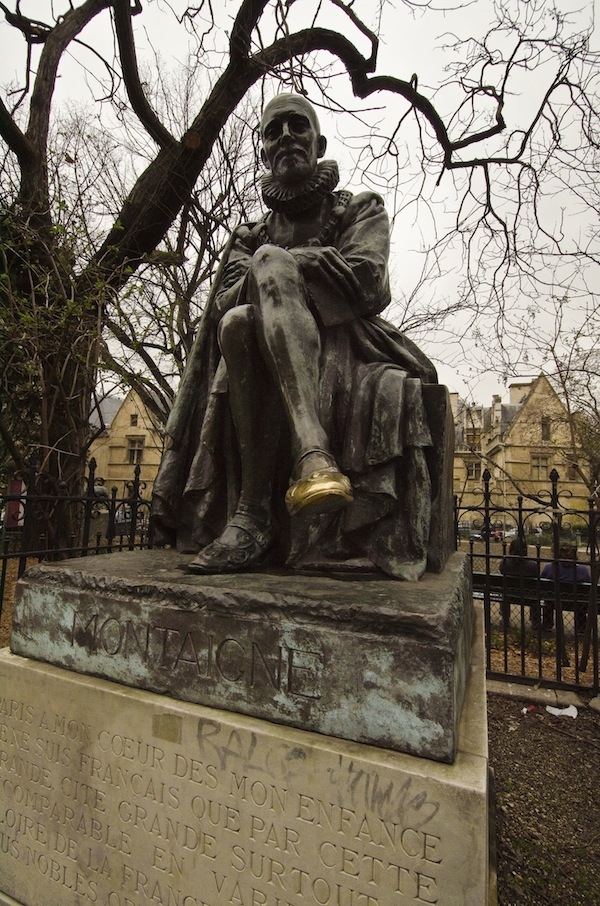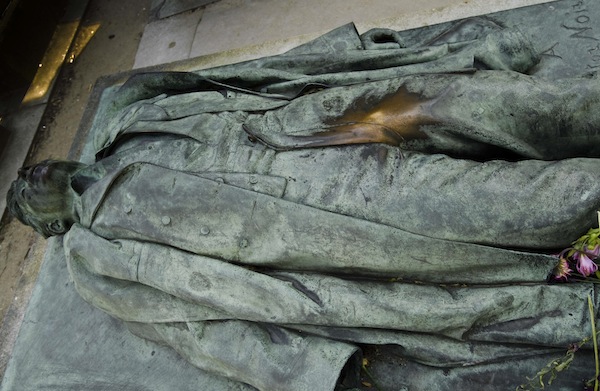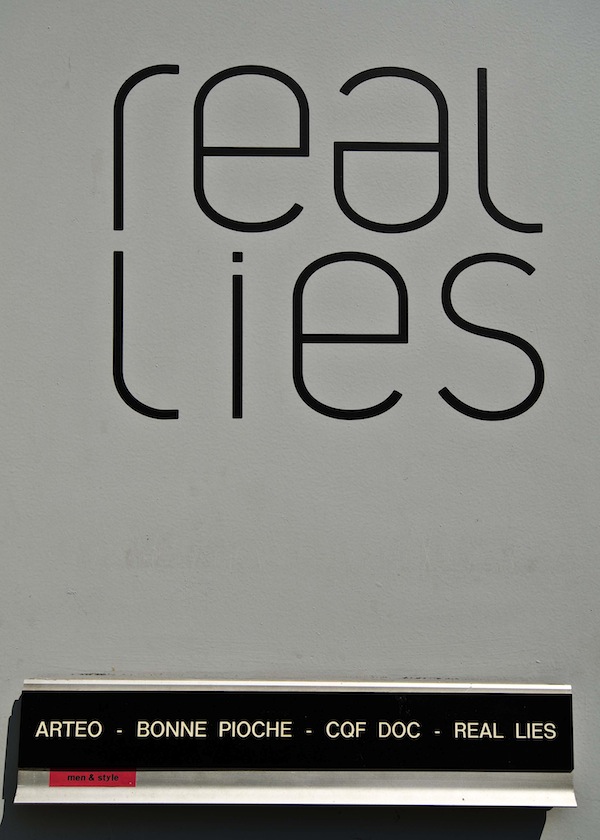Rub It For Luck
 05.14.2011
05.14.2011  It is good to rub and polish your mind against that of others.—-Michel de Montaigne, essayist (1533-1592)
It is good to rub and polish your mind against that of others.—-Michel de Montaigne, essayist (1533-1592)
Just around the corner from us, and a few blocks west down rue des Écoles (street of the schools), is a tiny public square, named for Paul Panlevé, a mathematician and physicist, and not terribly competent French prime minister, circa World War I.
The square is probably more famous for the life-sized statue of Michel de Montaigne, father of the essay, a rich and distinctive prose form which still enchants writers (and readers) to this day. The statue of a seated, pensive Montaigne faces the front door of the Sorbonne, across the street, probably the most famous of French colleges, part of the University of Paris since 1257. It was the Sorbonne and other schools of the early Middle Ages that taught in Latin until the French Revolution, giving our neighborhood its most common appellation, the Latin Quarter.
If you look closely at the Montaigne sculpture, you'll see that his connection to French education continues to this day, if not in the halls of the Sorbonne (we jest, of course he is taught there), at least in urban legend. The statue's bronze foot is worn to a golden patina because students believe it's good luck to rub his foot before an exam.
Are urban legends mere falsehoods, or real lies?
Who can say? But this tradition has crossed the Atlantic, too, at least as far as the College of William & Mary in Williamsburg, Virginia, the second college in the American colonies. There, students rub the shoe on the marble statue of the bewigged Lord Botetourt, the former English governor, also in the hope of good luck going into a big test or final.
And there's yet another French statue-rubbing tradition, this one in Paris' 20th arrondissement.
A couple of miles northeast of us (a brisk Sunday walk) is Père-Lachaise, Paris' largest cemetery, whose most famous tenant is probably the American singer Jim Morrison. It also houses (among others) Gertrude Stein, Oscar Wilde, Alice B. Toklas, Colette, Yves Montand and Simone Signoret (side by side), Sarah Bernhardt, Isadora Duncan, Edith Piaf, Stéphane Grappelli, Guillaume Apollinaire, Honoré de Balzac, Eugene Delacroix, Gustave Doré, Paul Eluard, Max Ernst, etc., etc.
And the writer Victor Noir.
Who?
To make a long story short, Noir (real name Yvan Salmon) was in 1869 a Paris journalist for a Corsican-language newspaper which, by insulting the long-dead Napoleon I, drew for its editor a challenge for a duel from the late emperor's grand-nephew, Prince Pierre Bonaparte, cousin of the then-ruling Emperor Napoleon III. The editor sent Noir and a buddy (both armed) to the prince's house in January, 1870, to work out the duel's terms, but, rather than acting as seconds (a sort of best man, or groomsmen at a duel) they mixed it up verbally with the prince, who, offended at the lack of proper custom, slapped Noir and shot him through the heart.
The prince was acquitted, of course, as he was rich and a Bonaparte, because Noir was armed, and because the prince testified that Noir slapped him first.
Noir was buried in another cemetery, but was later (1891, following the fall of the Third Republic and the Franco-Prussian war) disinterred and reburied in Père-Lachaise, honored with yet another life-sized statue (the French like life-sized statues). The sculpture, by Jules Dalou, depicts Noir as he fell, flat on his back, top hat next to his right hand. (And no weapon of any kind visible.)

Now, for some reason, perhaps because the statue is SO lifelike, and Noir was said to be something of a roué, the urban legend arose that rubbing Noir's rather prominent (but discreetly covered) private parts would cause the infertile to become fecund. In addition, placing a flower in the top hat and kissing his lips would add to the mojo.
Voila, Noir's endowment is burnished gold, just like Montaigne's foot.
Perhaps there is a real scientific study to be done someday by someone who has passed his or her finals at the Sorbonne. Let them choose their local urban legend and have at it. Falsehood, or real lie?
Whichever, the Noir-rubbing tradition, too, has crossed the Atlantic to New York.
There doesn't seem to be any reason for it, other than its size and prominence (his penis is about face-level on the average American), but the 12-foot-tall bronze Adam by the Colombian artist Fernando Botero in New York's Time Warner Center is also developing a distinct shade of Noir-gold, thanks to the rubs, pats, and who knows, maybe kisses, of New Yorkers and tourists alike.
Then there's Lincoln's Tomb in Springfield, Illinois, where people touch the tip of the bronze nose of the former president's likeness, also allegedly for luck. But that's too long a walk from our apartment to investigate.



Reader Comments (14)
Dear K & R,
I love the Montaigne statue (such relaxed brilliance!), but that Noir statue is fantastic! Who would think to depict a man in perpetuity, flat on his back, just the way he died? (Well, I guess Jules Dalou!) And that "Noir-gold" sheen... :) I suppose we could make it a verb, to say a statue has been "Noired" by luck-seeking hands?
I personally love (most) urban legends as there is something myth-making about them....the desire to reclaim stories and entertain possibilities and engage our imaginations. (Who doesn't conjure wild images when thinking of discarded baby crocodiles growing to gigantic proportion in the sewers of NYC?)
Thank you for sharing your adventures in statuary. :)
Love!
dawna
How much more gracious a myth than Midwesterners being probed by aliens. If I were still teaching English Comp (which, thank the good Lord in heaven I'm not), I would use this story as inspiration.
So much fun on a rainy Sunday morning in L.A. to read your dream.
Dear Kaaren and Richard,
I wish everyone would rub my penis as they pass. I guarantee that good fortune would befall one and all.
Bruce
Ah Kaaren and Richard:
What juicy history you share with us today! I kept imagining these American tourists (women) stroking Monsieur Noir with delight. It also brings to mind Mick Jaggar and the Stones album "Sticky Fingers."
until then,
Love Jon
Hi Dawna,
There's something alchemical going on here, isn't there? Turning lead (or bronze) into gold by the power of frenetic desire.
Maybe we should say instead of "Noired," that a statue has been "golded." No, that sounds too much like gelded. Goldified?
Maybe writing fiction is a higher form of creating urban legends, since it uses imagination and story in a similar but (usually) more refined and complex way.
Speaking of creating urban legends in fiction, I'm half way through "The Master and Margarita." Bulgakov transforms the way one thinks of mental illness forever. Not to mention his conception of the devil and Christ. Instead of giant crocodiles in the sewers of NYC, we get giant cats in the parks and streets of Moscow.
We live in a wild wild world!
Thank you and love,
Kaaren and Richard
Anna!
This is a funny comparison. I wonder if the being-probed-by-aliens myth is a way for Calvinists to disguise unacceptable sexual fantasy?
So glad you are free of any work that you do not love to do. From what I've heard from other teachers, teaching English Comp involves teaching what students were not taught from grammar school on. No easy task to try to cram seven or eight years of learning into one.
It's odd to hear of rain and gray skies in L.A. when it's sunny and hot here. The world weather is turning upside down.
Thank you!
Love,
Kaaren and Richard
What validating fun. Unlimited mojo is available and I respect that we each have a very personal relationship to this aspect of numinosity. Applying mojo to get a good parking space is very pragmatic. Out of necessity, I learned and developed the skill while living in Los Angeles. Your article has expanded my ideas about means and reasons for invoking mojo via patting, rubbing, kissing, who knows... Between intention, shared DNA of others with similar intentions, and the symbolic gesture itself, there is bound to be co-creative power there. Love it! Thank you.
Marguerite Baca
Dear Marguerite,
A friend taught me this parking mojo: before you pull into a parking lot, you picture an empty space. A very clear picture, with no doubt. It works for me about nine times out of ten. Or should I say, it worked while we were in Los Angeles. (I'm happy not to need it now in Paris.) What do you do to get a parking space?
And the Victor Noir mojo suggests ways to attract some lovely, rambunctious man into your life, though I'd guess you probably have one already.
We're all just creating our own paradise as fast as we can, however we can, yes?
How I miss your yoga classes!
Love,
Kaaren (& Richard)
Dear Bruce,
Hilarious. I certainly hope you get your wish, and soon! Everyone could use some good luck.
Love,
Kaaren & Richard
I too like rubbing and yes kissing feet too...and it tends to lend a prominence to my member...
Bob,
It is good to be a prominent citizen, who is not averse to expressing affection. We salute you, Monsieur Waks!
XO,
Kaaren & Richard
Hi, Kaaren,
A reply to your post upstream:
Yes, alchemical and hopeful. And, yes, "noired" is ironic, no? (Or a paradox?) Glad you're reading the Bulgakov - a book I loved when I read it a few years ago, completely taken in by his humor, his imagination, and his prose, as well as the dark political undercurrents of the book. Here's a wonderful web site about the book that includes extensive character profiles (and their real-life inspirations), maps and photographs around Moscow of the places where Begemot (inspired by the author's pet cat Flyushka - see photo on the site) & company traversed, as well as short essays on themes, especially those related to life under the Stalinist regime: Bulgakov's Master and Margarita
Enjoy!
Love,
dawna
Hi Jon,
The juicier the better, right? But I do not think it is just American women who appreciate Monsieur Noir. I do believe that he has international appeal, as well as appeal to more than one gender. Richard reports that when he was there for his photo shoot, a couple of Italian women were paying Victor giggling homage.
Now I'll think of Mick Jagger whenever I see this monument to Victor Noir. Thank you.
XOXO,
Kaaren (& Richard)
Dear Dawna,
Thank you for the link to the Master and Margarita site. I read about the characters and was intrigued to find, after just reading in the book his first reference to Margarita as Queen Margot, that he conflated this character based on his third wife and great love, with the Queen Margot on whom we did a post. I'm three-fourths of the way through the novel, and though I'm knocked out by his imagination, I'm noticing a difference between Russian surrealism and French. The former is much darker, more oppressive (bien sûr, since Bulgakov's books were banned during Stalin's reign) than the French. And it may be too soon to say this, but I think I'm partial to French surrealism. I'll wait though to read the whole book before coming to any conclusions.
But making a character a large evil cat-- well, that is just hard for me to swallow. Not the surrealism of the cat and his antics--rather, that Bulgakov could conceive of a cat as a wholly negative character. Blasphemy! Marley just bristled at this.
Love,
Kaaren (& Richard)